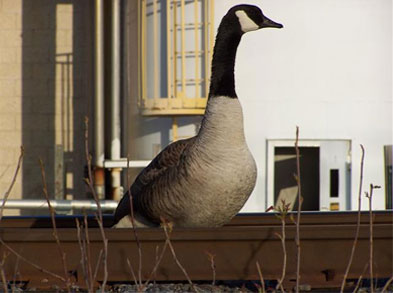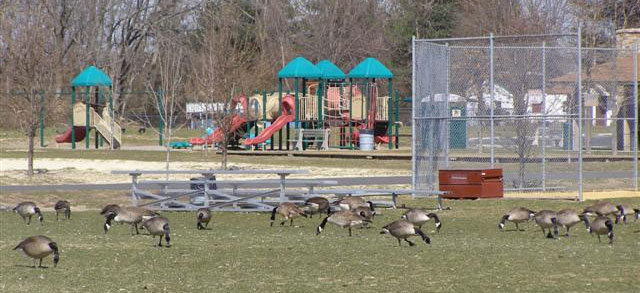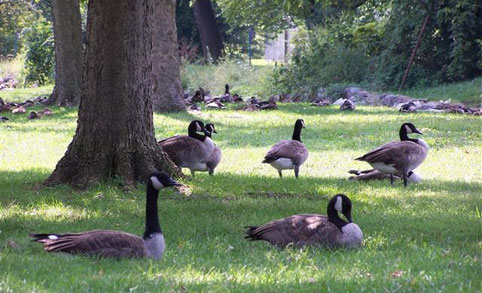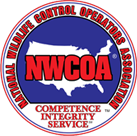CANADA GOOSE
Common Concerns & Safety Issues
Customers & Locations
Athletic Fields
Golf Courses
Lake Front Properties
Private Communities
Industrial Sites
Townships
County Governments
Boroughs
Schools
Municipalities
Professional Solutions
- Program design
- Population control
- Hazing techniques for flock dispersal and reduction.
- Adherence to U.S. Fish and Wildlife Service permitted guidelines
Understanding the
CANADA GOOSE
| Grouping | Waterfowl / Herbivore |
| Nicknames | Canadian Geese, Honkers, Lawn Cow, Winged Cow, @#$%^&*! |
| Best Known For | Their distinct honk and unique coloration patterns with white cheek plates. They are also known for their v flight pattern and agressive nest guarding. |
| Life Span | 15 to 20 years. |
| Mating Season | Geese become reproductively active their 3rd year of life. Mating occurs for life. Nest building and courtship begin in February and can extend well into April/May. |
| Reproductive Details | 4 to 10 eggs with 5 to 6 on average. Eggs are 2-3 times the size of a chicken egg and white in color. One egg is laid per day until all eggs have been placed in the nest. Incubation begins at the same time for all eggs. Typically 1 clutch per year. Sometimes geese will re-lay eggs if nest is destroyed early during the incubation period. |
| Dispersal | Family units stay together through summer and some dispersal occurs through the fall. Resident geese do not migrate. |
| Habitat | Open turf grass areas are preferred for feeding locations. Open waterways including rivers, ponds and lakes are preferred locations for protection from predators. Also, athletic fields, business parks, retention and detention pond areas and corporate campuses. Geese are very at home in our suburban environments. They are commonly seen nesting and living in housing subdivisions and business parks with detention ponds. |
| Activity Cycle | Nest selection and mating occur January through April. Molting (temporary loss and re-growth of flight feathers) occurs June and July. August to October young are mature and geese are often found pond-hopping. November thru January, resident geese may be absent due to heavy snow cover and ice; moving to areas with open water and accessible feed. |
| Food | Graze on wild and cultivated plants however, fine bladed turf grasses are preferred. Other foods include algae, clover, wheat, corn, barley, rye, and consume up to 4 pounds of grass each day. |
| Damage Signs | Signs include pond bank erosion from over-grazing and walking. Damaged turf areas due to over-grazing and elevated fecal coliform levels in the water. Elevated fecal coloform levels in the water, fecal matter present in turf areas and on sand beaches. Geese produce up to two pounds of poop per day and create slip hazards on walk and parking areas. |
| Treatment | Various visual and audio harassment techniques. Egg treatment, roundups during molt, regulated shooting where permissible, trained dogs, fencing. |
| Risk and Disease | The Canadian Geese are aggressive nest guarders and will flog or bite intruders (including humans). Related to fecal matter, exposure to e-coli and salmonella are present. |
| Nests | Typically a hollowed out depression in gravel, rocks and earth. Often lined with a substantial amount of chest down. During egg laying the nest will often be camouflaged. In human environments, nests are often found in parking lot islands, shrubbery beds against buildings, elevated planting containers, and roof tops. Rooftop nesters will coax their goslings to jump off of the roof to the ground below. Their soft, squishy bodies break the fall, even on asphalt and concrete. |
| History & Phenomenon | Resident geese have never been involved in any historical migration. They are born locally, stay local, and die local. The large high-flying flocks of geese barely visible from the ground, typically seen in the early spring and late fall, are their migrating and thus non-resident cousins. Migrating geese will stop locally on their travels north and south to rest, refuel, and have social time with distant relatives, just like people at Thanksgiving and Christmas. And just like people, who grow tired of relatives, they eventually leave. |



Integrated Goose Management approach (IGM) utilizes:
~ Educational Programs
~ Population Control
~ Addling
~ Round-Ups
~ Hazing Methods
~ Chemical Treatments
~ Physical barriers
~ Visual Deterrents
~ Habitat Modification
Integrated Goose Management Details
Staff TrainingFor those who want their staff either partially or fully involved in the management plan.
CGM will provide the level of training you will need.
Addling
"Egg Addling" enables the affected property owner/manager to reduce or eliminate, for that particular season, (March through May) the growth of the flock through birth rate. Addling is birth control in action. Addling of the egg can be done by several methods. The female will continue to sit on the eggs, unknown to her that they will not hatch. Eventually, she will leave the nest after egg laying season is over. Though a simple task, addling requires one to search through heavy cover, endure ticks and mosquitoes, and the occasional flogging by an aggressive gander. Federal permits from the US Fish and Wildlife Service are required to perform this work.
‘Round ups'
During the molt (flightless period in June and July), the geese are gathered into a corral and then loaded for transport. The skill of the ‘cowboys’ makes the process look simple. Requiring a short amount of time to perform, the actual event requires thoughtful pre-planning and coordination. Federal permits from the US Fish and Wildlife Service are required to administer this work, as well as a co-signature by local authorities in some states. Due to the length of time necessary to process permits and the limited number issued, CGM strongly suggests beginning the process of permit preparation and filing eight months in advance.
Hazing
This group of techniques is the most well known, and oftentimes the most practical. Hazing impacts geese from the aspect of safety, also keying in on the instinct of self preservation.
Physical Barriers
Physical barriers work in two ways; one, by impacting safety and two, by obstruction.
Safety is a concern for any goose. When safety is not assured, it is time to find another site. Geese prefer visually unobstructed areas as opposed to confined areas with limited visibility. Properly designed landscaping plantings can turn an ‘open area’ into a ‘confined area’ from a goose’s perspective. Obstruction is typically used to keep geese from a water source. This method of control consists of fences, electric and non-electric, nets, floating balls, and grid systems which inhibit landing. Grids and barrier fencing, though successful methods of limiting access to geese, also interfere with the use of these areas by people. Implementation of physical barriers can be differnt in many applications
Visual Deterrents
The object of visual and audio deterrents is to remove the element of safety from a site and initiate the self-preservation instinct of the geese. Though excellent tools, the use of these types of deterrents alone produces quickly diminishing results. Visual and audio deterrents work best in combinations with each other and with other deterrents. Visual deterrents include predator effigies, decoys, kites, Mylar tapes, and balloons. Audio deterrents include recorded distress calls, predator calls, explosive noises, and propane cannons.
Habitat Modification
Habitat modification is the least practical but can have dramatic results. Included in this category are landscape changes. Changing grass type and length can impact geese feeding habits. Covering pond banks with climbing obstacles such as ‘rip-rap’ impacts the geese’ ability to traverse to and from an area. Anti-feeding ordinances are also included in this grouping.


Integrated Wildlife Management is our comprehensive and effective one-stop solution. This approach brings together the six necessary elements to successfully resolve wildlife / human conflicts and when possible, safely relocate wildlife to a more suitable habitat.


